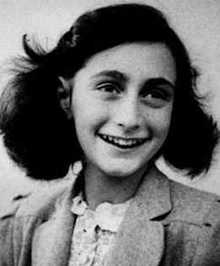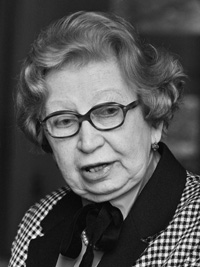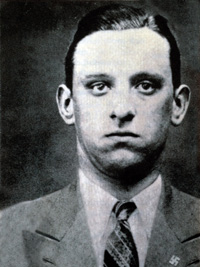|
Anne Frank
Answer
to Name
This Famous Person Game - September 2015
by Mike McLeod
|
 |
|
|
Aug. 1, 1944
- Tuesday
No one knows Anne's better side, and that's why most people can't stand me. Oh, I can be an amusing clown for an afternoon, but after that, everyone's had enough of me to last a month. Actually, I'm what a romantic movie is to a profound thinker—a mere diversion, a comic interlude, something that is soon forgotten…. –Diary of a Young Girl, by Anne Frank, p. 375
 This was a part of Anne Frank’s last entry in her diary. Seventy-one years later, that talkative, Germany-born Jewish girl is as well known as the famous movie stars of the 1930s and ‘40s she adored, and it is highly unlikely that she will ever be forgotten. Diary of a Young Girl has sold 31 million copies in 67 languages. This was a part of Anne Frank’s last entry in her diary. Seventy-one years later, that talkative, Germany-born Jewish girl is as well known as the famous movie stars of the 1930s and ‘40s she adored, and it is highly unlikely that she will ever be forgotten. Diary of a Young Girl has sold 31 million copies in 67 languages.
In her final diary entry, there was no hint of Anne thinking that she, her family and the four other people hiding with them would be discovered. Yet, three days later on the morning of Friday, Aug. 4, 1944, SS Sergeant Karl Silberbauer and several Dutch security personnel arrived at the building in Amsterdam where Anne’s family had been hiding for two years. The Nazis were tipped off. Although circumstantial evidence has implicated several people, no one has been indicted for collaborating with the Nazis in the arrest of the Franks and the others. Seven of the eight arrested died in the death camps. Anne’s father Otto was the only one who survived.
Before the war, Otto Frank saw the storm clouds on the horizon and spirited his family away from their home in Germany to Holland. He tried to get his family out of Europe, but declarations of war between Germany and the United States ended his chance of getting visas. He was left with only one viable option—go into hiding.
Otto prepared for about a year for their disappearance. With the aid of a few close co-workers, he prepared rooms on two floors and in an attic in the huge office building/warehouse of Opekta, the company where Otto worked as managing director. (Opekta made and distributed pectin used in jam making.) Otto stored a huge amount of canned food in the Annex beforehand, and while they were in hiding, office assistant Miep Gies (pronounced “Meep Geese”; she passed away on Jan. 11, 2010) regularly purchased fresh food for them with black market ration cards. The others who aided the Franks were Victor Kluger, Johannes Kleiman and Bep Voskuijl (pronounced “Bep Foze-kowl.”)
|

|

|

|
|
Otto Frank in 1961. He passed away on Aug. 19, 1980. (Photo: Jac. de Nijs/Anefo.)
|
Miep Gies, 1987. (Photo: Rob Bogaerts /Anefo.)
|
Karl Silberbauer, the SS sergeant who arrested the Franks.
|
The website AnneFrank.org features an excellent computer-animated tour—interspersed with actual photos—of Anne’s “Secret Annex,” as she called it.
Nov. 19, 1942
Countless friends and acquaintances have been taken off to a dreadful fate. Night after night, green and gray military vehicles cruise the streets. They knock on every door, asking whether any Jews live there. If so, the whole family is immediately taken away. If not, they proceed to the next house. It's impossible to escape their clutches unless you go into hiding. They often go around with lists, knocking only on those doors where they know there's a big haul to be made. They frequently offer a bounty, so much per head. It's like the slave hunts of the olden days. I don't mean to make light of this; it's much too tragic for that. In the evenings when it's dark, I often see long lines of good, innocent people, accompanied by crying children, walking on and on, ordered about by a handful of men who bully and beat them until they nearly drop. No one is spared. The sick, the elderly, children, babies and pregnant women—all are marched to their death. We're so fortunate here, away from the turmoil. We wouldn't have to give a moment's thought to all this suffering if it weren't for the fact that we're so worried about those we hold dear, whom we can no longer help. I feel wicked sleeping in a warm bed, while somewhere out there my dearest friends are dropping from exhaustion or being knocked to the ground. I get frightened myself when I think of close friends who are now at the mercy of the cruelest monsters ever to stalk the earth. And all because they're Jews. –p. 75
Because of their compassion and preparation with sufficient food, the Franks invited four other people to hide with them. They didn’t have to do this, but out of compassion, they attempted to save four other people.
While in hiding, the families had to whisper to avoid detection. When workmen entered the building to make repairs, all of them were forced to remain still and quiet, sometimes for hours, until the workmen left. This was particularly difficult for chatterbox Anne.
As you can imagine, the accommodations became somewhat cramped for the eight people who lived in the Secret Annex 24/7. Add to this the tension of the constant possibility of discovery by the Nazis, and it is easy to understand why nerves frayed and tempers sometimes flared.
In addition to newspapers and movie magazines (specifically brought to Anne), the eight in hiding were kept informed of the news and the war’s progress by listening to a radio in a company office. The group was ecstatic when they learned of the D-Day Invasion that occurred on June 6, 1944, and they were confident that Holland would be liberated by October of that year. Unfortunately, that did not occur until May 5, 1945.
During their arrest on Aug. 4, 1944, the families’ valuables were confiscated. Sergeant Silberbauer needed something to put them in so he grabbed Otto Frank’s leather briefcase. Opening it, he unknowingly found Anne Frank’s diary inside—she stored it there for safekeeping. For a brief moment, the Nazi sergeant held the fate of Anne Frank’s diary in his hands. Not knowing of its great importance to history and future generations, he dumped it and the other papers in the briefcase onto the floor.
Looking back, it is safe to say he probably wished he had left the valuables and taken the diary instead. Many years later, Silberbauer said, “I bought the little book last week to see if I am in it. But I am not. Maybe I should have picked it up off the floor.”1
At the same time, two of Otto Frank’s co-workers, Victor Kluger and Johannes Kleiman, were also arrested. Miep Gies and Bep Voskuijl were not taken into custody since they were not considered to be authority figures in the office. Kleiman was released from imprisonment after a few months due to his poor health. Kluger was sent to forced labor camps, but escaped at the end of March 1945 during an air raid. Making his way back to his home, he hid there for a month until Holland was liberated.
After the families were hauled off, Miep Gies went to the Annex and picked up Anne’s diary and the papers. She saved them and returned them to Otto Frank after the war.
The Frank Family and the others were sent to Auschwitz, and then Anne and her sister Margot were transported to the Bergen-Belsen concentration camp in northern Germany. Some believe Anne died just before the camp was liberated; however, new research points to both sisters probably dying in February of 1945 from typhus, probably six or eight weeks before the liberation on April 15, 1945. Typhus is a lice-born disease that usually kills its victims in less than two weeks once symptoms appear; Anne and Margot were seen with those symptoms in early February.
The following is a glimpse of what Anne experienced: “‘Days at the camp were filled with terror and dread,’ witnesses said. The sisters stayed in a section of the overcrowded camp with no lighting, little water and no latrine. They slept on lice-ridden straw, and violent storms shredded the tents, according to the researchers. Like the other prisoners, the sisters endured long hours at roll call. Her classmate, Nannette Blitz, recalled seeing Anne there in December 1944: ‘She was no more than a skeleton by then. She was wrapped in a blanket; she couldn't bear to wear her clothes anymore because they were crawling with lice.’”2
Along with Anne and Margot, 35,000 prisoners in the camp died of starvation, typhus and other diseases during a period of just three and one-half months from January to April 15, 1945 when the 11th British Armoured Division liberated the camp. In all, about 70,000 people died in Bergen-Belsen.
Collectibles relating to Anne Frank are few, and most concern her book. Three first edition copies of Anne Frank, The Diary of a Young Girl: June 14, 1942-August 1, 1944 in Dutch, Hebrew and Yiddish were sold for $3,750 (including buyer’s premium) on Nov. 25, 2014 by Kedem Auction House LTD in Jerusalem, Israel.
One lot of personal effects relating to Anne Frank did come to auction in 1988. A group of two letters, a postcard and two passport photos sent in 1940 by Anne and Margot to pen pals in Iowa sold for $165,000.
Few people know Anne Frank was a postcard collector. In one of the letters sold, she stated that she had a collection of “about 800.”3 Before going into hiding, Otto Frank took Anne’s postcard collection to the Secret Annex so their hiding place would seem a little like home for his daughter.
Marie “Anne” Frank was born on June 12, 1929 in Frankfurt, Germany, and she died in February 1945 at the age of 15 in Bergen-Belsen. Despite her firm belief that she would never be remembered, Anne Frank will never be forgotten.
May 22, 1944
It's really a wonder that I haven't dropped all my ideals, because they seem so absurd and impossible to carry out. Yet I keep them, because in spite of everything I still believe that people are really good at heart.
Anne Frank was correctly identified by: Jean Fricht of Jasper, Ga.; Julie Kimbrell of Old School Antique Mall in Sylva, N.C.; Jim Pruett of Eastbrook Flea Market and Antique Mall in Montgomery, Ala.; Jeff Leibowitz of York, S.C.; Randy Robinson of Springville, Ala., Ted Carlton of Utah, Caryl Ponder of Carriage House Antiques of Bradenton, Fla., Dr. Scott and Carolyn Brown of Montgomery, Ala., Lucy Way of Knoxville, Tenn., Florence Anne Berna, Visitor Center Manager of the Roswell Convention and Visitors Bureau, and Debra Anderson of Jersey, Ga.
---------------------------------------------
Quotes from Anne Frank, The Diary of a Young Girl are courtesy of Readanybook.com.
1 The Independent, Independent.co.uk, Nazi who arrested Anne Frank became a spy for West Germany,” by Tony Paterson, April 11, 2011.
2 CNN.com, “Researchers say Anne Frank perished earlier than thought,” by Madison Park, Aril 1, 2015.
3 New York Times, NYT.com, “Letters by Anne Frank Auctioned for $165,000,” by Rita Reif, Oct. 26, 1988.
Sources:
AnneFrank.org
Holocaustexplained.org
Wikipedia.org
Dutch name translations courtesy of Kimberly Nelson.
Learn
about more Famous People
|